This useful guide to exploring Naejangsan National Park will give you the best options for how to go to Naejangsan National Park – one of Korea’s fall foliage hotspots. It will also provide a brief overview of the sights, locations, attractions, and food available at Naejangsan and why you should definitely visit. One of South Korea’s most beautiful fall foliage spots.
Naejangsan National Park is a treasure trove of stunning sights, uniquely Korean views, and peaceful spots to connect with nature and Korean culture. Literally meaning ‘concealed inside’, Naejangsan (Naejang Mountain) certainly has a lot of hidden wonders to provide visitors with awe-inspiring photo opportunities, unforgettable moments, and the chance to find spiritual calm among natural beauty.
Lush forests line the sides of the numerous small mountains, whilst the long, pleasant valley has been carefully crafted over the years with long, winding maple-tree lined roads. Follow slowly flowing streams through the valley, explore traditional Korean Buddhist temples, and marvel at the natural wonders on display in this beautiful national park. Find out why Naejangsan is one of the top 10 most beautiful places in Korea.
Affiliate Disclaimer: This site contains affiliate links and I may earn commission for purchases made after clicking these links.
How To Go To Naejangsan National Park
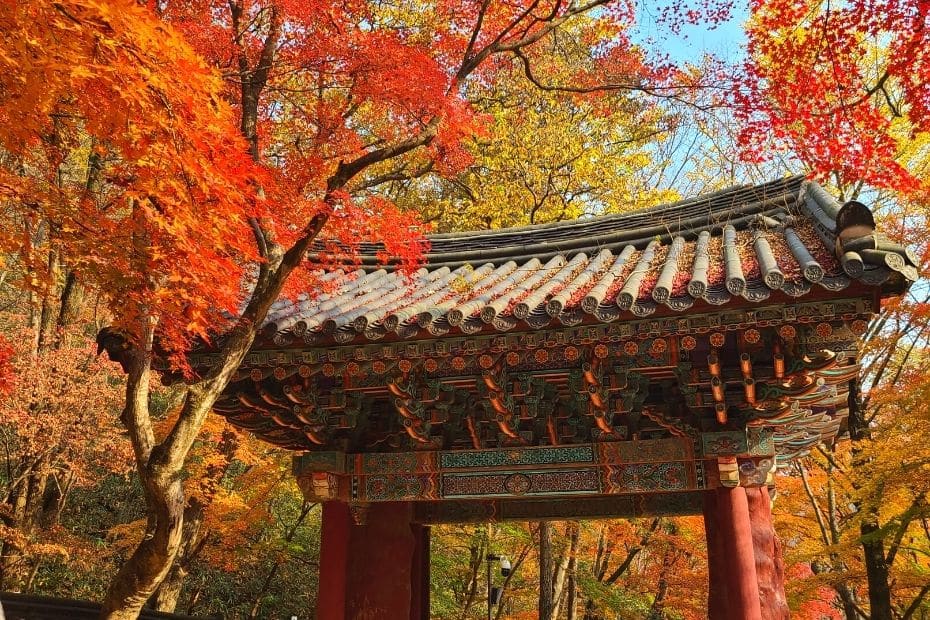
There are three main ways to go to Naejangsan National Park in Jeollabuk-do. You can get to Naejangsan National Park by car, train, or bus. If you don’t drive, taking the train is a faster option, but the bus will be cheaper and runs more frequently. Below are details about each of these travel methods.
How To Go To Naejangsan By Car
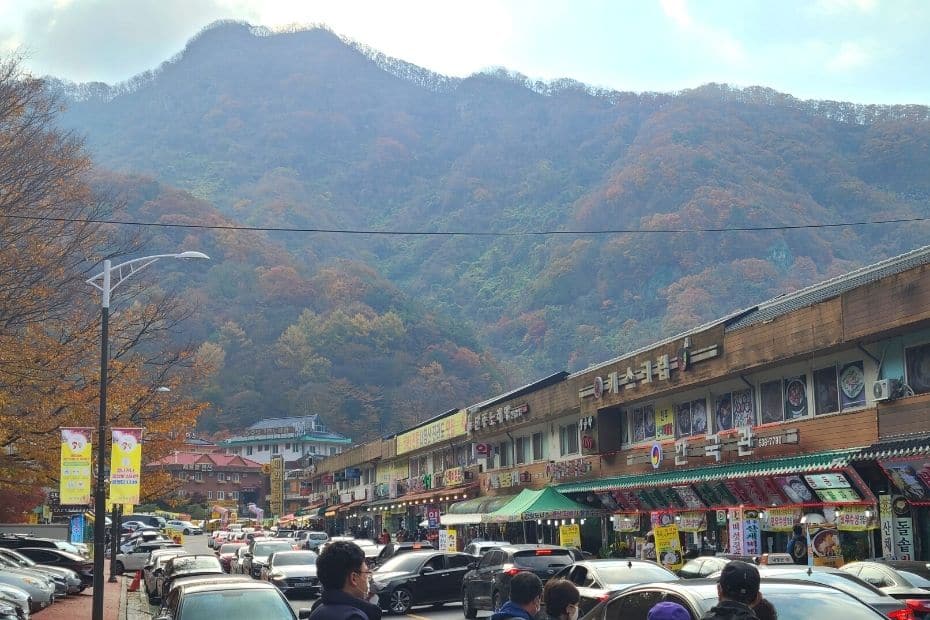
To get to Naejangsan National Park by car, head towards the park’s entrance at the Naejangsan Rest Stop (pictured above).
It should take under 3 hours to drive from Seoul to Naejangsan National Park, however, during peak fall foliage season it may take a lot longer.
It may be best to leave very early or stay overnight the previous night in nearby Jeongeup City to beat the traffic and get in before the crowds.
Naejangsan Rest Stop:
In Korean – 내장터미널휴게소
Time From Seoul:
2 hours 40 minutes
(longer during peak season)
How To Go To Naejangsan By Train
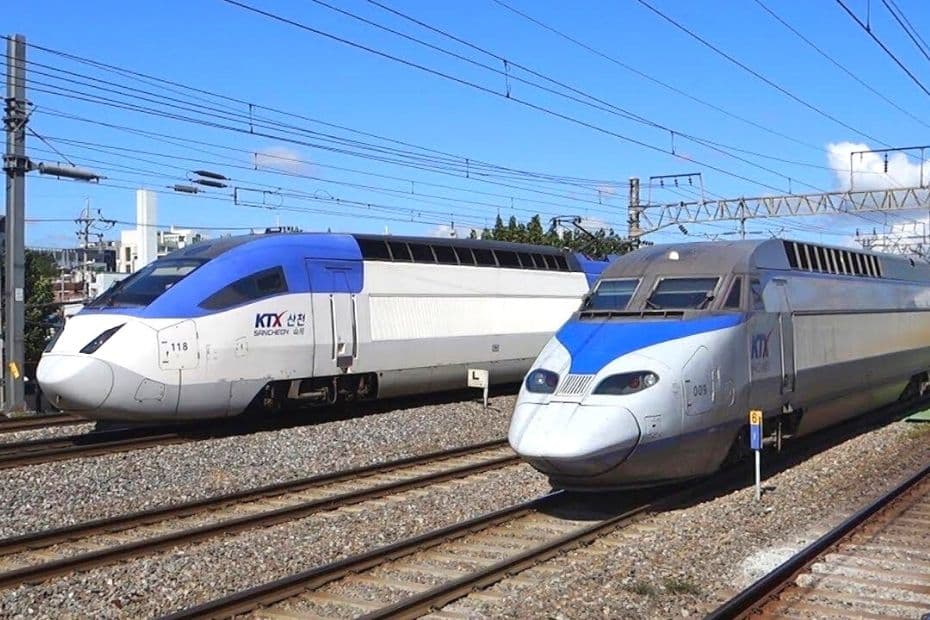
To go to Naejangsan National Park by train, you should take the KTX (Korea’s high speed train) as below:
Seoul Station
to
Jeongeup Station
Once you get to Jeongeup Station, walk outside the main entrance and catch local bus 171, which goes directly to Naejangsan National Park entrance.
Alternatively, you can take a taxi from the bus terminal to the Naejangsan Rest Stop (내장터미널휴게소).
Jeongeup Train Station:
In Korean – 정읍역
Time From Seoul:
1 hour 35 minutes
(then bus 171 – 30 minutes)
Cost:
39,000 KRW (Adult)
19,900 KRW (Child)
Please note: There are only a few KTX trains from Seoul to Jeongeup each day. Be sure to check travel times and book in advance.
How To Go To Naejangsan By Bus
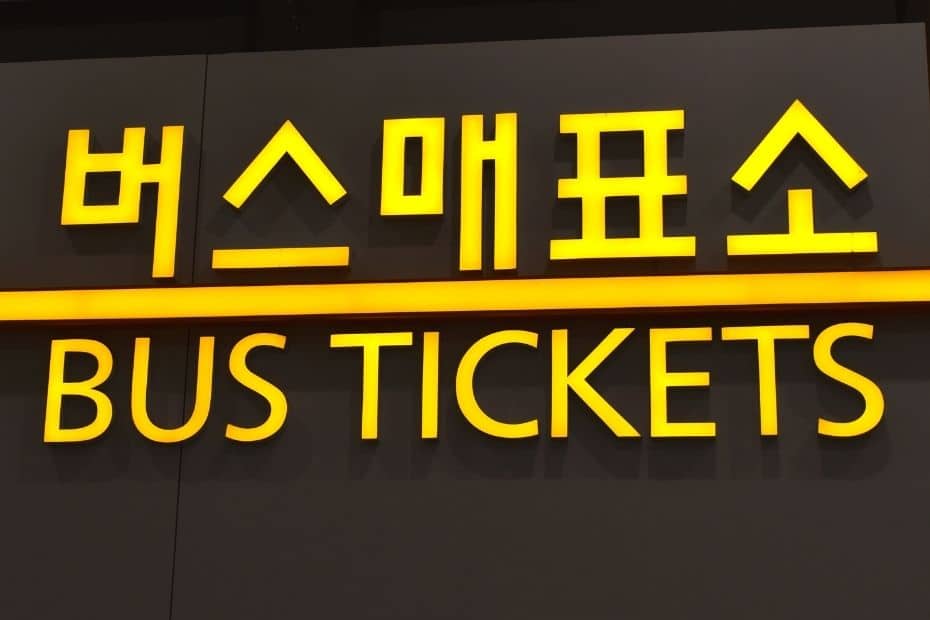
To go to Naejangsan National Park by bus, you should take the intercity bus as below:
Seoul Central City Bus Terminal
to
Jeongeup Station
Once you get to Jeongeup Bus Terminal, walk towards Jeongeup Station main entrance and catch local bus 171, which goes directly to Naejangsan National Park entrance.
Alternatively, you can take a taxi from the bus terminal to the Naejangsan Rest Stop (내장터미널휴게소).
Jeongeup Bus Terminal:
In Korean – 정읍시외버스공용터미널
Time From Seoul:
2 hours 55 minutes
(then bus 171 – 30 minutes)
Cost:
Economy – 15,800 KRW
Luxury – 23,200 KRW
If you’re visiting Naejangsan from other cities, check the times from the links above from your city to Jeongeup – this is the main transfer point to get to Naejangsan National Park.
When visiting from Daejeon, I take the Mugunghwa (slow train), ITX, or KTX to Jeongeup Station from Seo-Daejeon Station.
Planning to visit Korea? These travel essentials will help you plan your trip, get the best deals, and save you time and money before and during your Korean adventure.
Visas & K-ETA: Some travellers to Korea need a Tourist Visa, but most can travel with a Korean Electronic Travel Authorisation (K-ETA). Currently 22 Countries don’t need either one.
How To Stay Connected: Pre-order a Korean Sim Card or a WiFi Router to collect on-arrival at Incheon Airport (desks open 24-hours). Alternatively, download a Korean eSIM for you travels.
Where To Stay: For Seoul, I recommend Myeongdong (convenient), Hongdae (cool culture) or Gangnam (shopping). For Busan, Haeundae (Beach) or Seomyeon (Downtown).
Incheon Airport To Seoul: Take the Airport Express (AREX) to Seoul Station or a Limo Bus across Seoul. Book an Incheon Airport Private Transfer and relax to or from the airport.
Korean Tour Operators: Tour companies that have a big presence in Korea include Klook, Trazy, Viator, and Get Your Guide. These sites offer discounted entry tickets for top attractions.
Seoul City Passes: Visit Seoul’s top attractions for free with a Discover Seoul Pass or Go City Seoul Pass. These passes are great for families and couples visiting Seoul – you can save lots.
How To Get Around: For public transport, grab a T-Money Card. Save money on Korea’s high speed trains with a Korea Rail Pass. To see more of Korea, there are many Rental Car Options.
Travel Money: Use money exchanges near Myeongdong and Hongdae subway stations for the best exchange rates. Order a Wise Card or WOWPASS to pay by card across Korea.
Flights To Korea: I use flight comparison sites such as Expedia and Skyscanner to find the best flights to Korea from any country. Air Asia is a good option for budget flights from Asia.
How To Learn Korean: The language course from 90 Day Korean or Korean Class 101 both have well-structured lessons and lots of useful resources to help you learn Korean.
When To Visit Naejangsan For Autumn Foliage
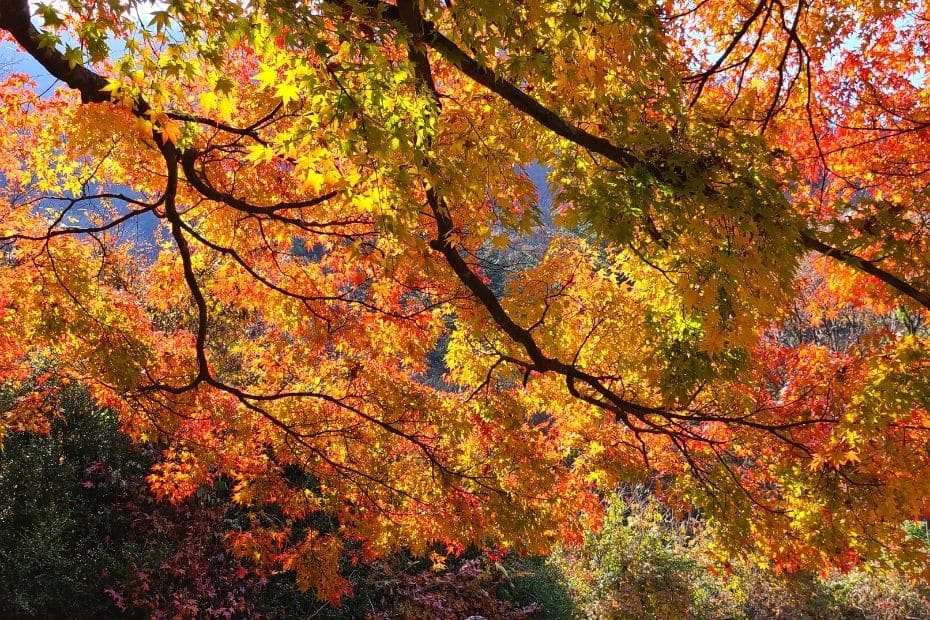
The best time to visit Naejangsan for fall foliage is the first week of November. The leaves start to change colour from mid-October, with the final leaves falling by mid-November.
As this is the best time to visit Naejangsan, you can find all the restaurants and food stalls operating, as well as some pop-up stalls selling souvenirs and snacks. This occurs at the main entrance, as well as outside Naejangsa Temple.
The first week of November will also be the busiest, expect large crowds and heavy traffic during this week. Plan your trip in advance and be sure to leave plenty of time for traffic jams. Avoid leaving the park around 4pm as this can be the busiest time.
Other great times to visit Naejangsan National Park are spring (mid-March to early June) and from the end of summer (early September), when the heat has dropped a bit, until the end of fall (mid-November).
For more information about when to go hiking in Korea’s very different seasons, check out this guide about When To Hike In Korea.
For more information about where and when to see fall foliage in Korea, check out these articles:
Fall Foliage Spots In Korea: The best places to see fall foliage across Korea. From national parks to palace grounds.
Korean Autumn Leaves Pictures: 45 beautiful pictures of Korea’s colourful autumn leaves.
October In Korea: Find out what to do, see, eat, and experience in the best month in Korea. Lantern festivals, fireworks, holidays, fall foliage, and lots more.
What To See At Naejangsan National Park In Autumn

Being in Naejangsan National Park, especially during autumn, is a treat in itself. Of course, there are some attractions that you won’t want to miss as you explore this relatively small, but tranquil national park.
Some of the top sights include:
Maple Tree Tunnel
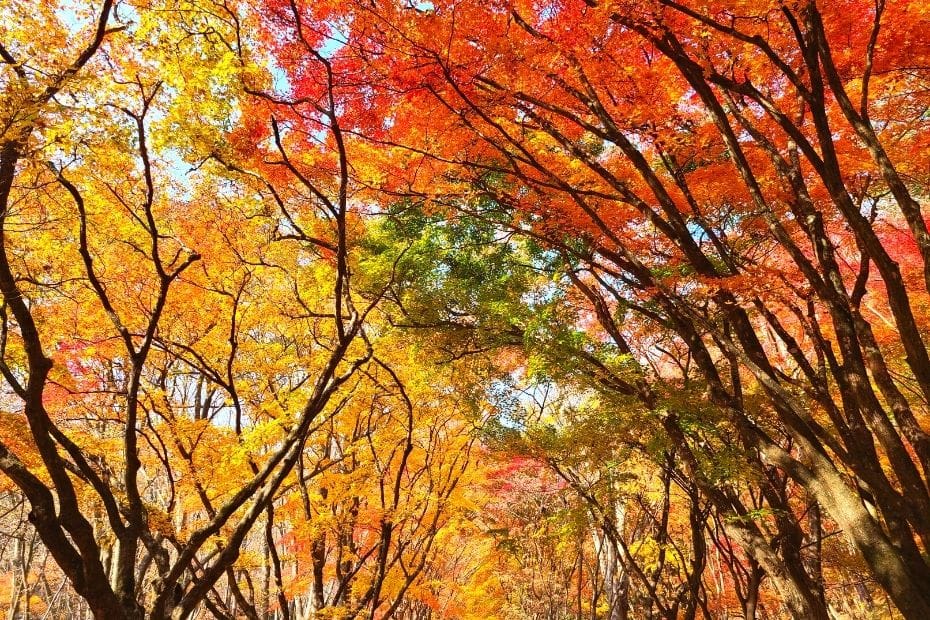
A true spectacle bursting with colour during autumn in Korea, the Maple Tree Tunnel is the first breathtaking sight you’ll experience at Naejangsan National Park.
You’ll pass under the rich reds, shining golds, and vibrant greens on display from hundreds of maple trees on the path connecting the park’s entrance and Naejangsa Temple.
Visitors can either walk along this path after arriving, or can take a shuttle bus to the temple area and watch it from the window. Walking is definitely recommended.
Naejangsa Temple
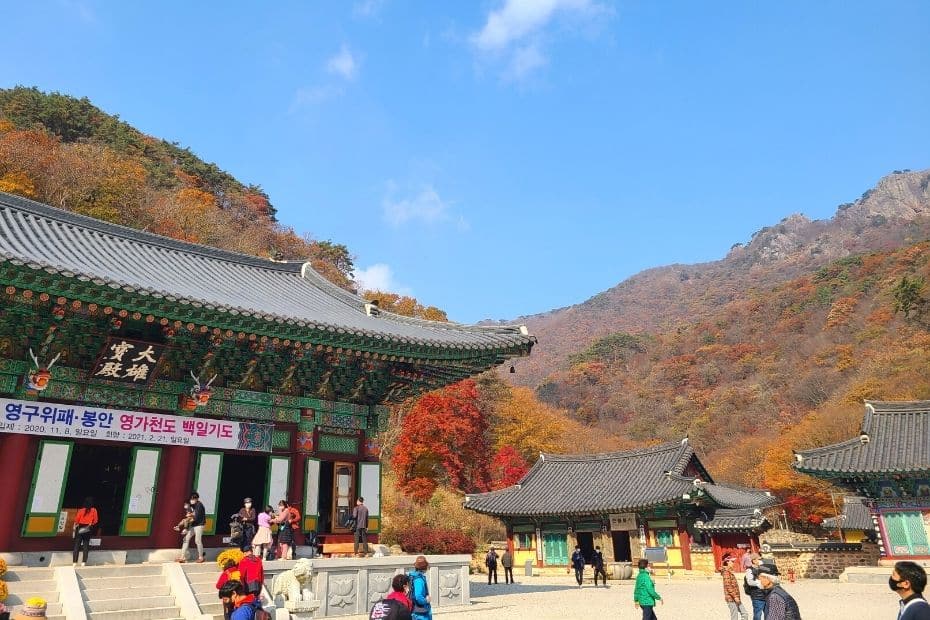
Nestled in the heart of Naejangsan National Park, surrounded by some of the oldest, wisest ginkgo trees, is the superb Naejangsa Temple. Inhabiting the area since the 7th Century AD, this carefully reconstructed temple is beautiful inside and out.
Cradled among soaring peaks and leafy trees, the traditional Buddhist temple buildings feel like they’re a part of nature. Take a moment to sit by the small pond outside, close your eyes, and reconnect with your spiritual side.
2022 Update: Sadly, the main temple burnt down in 2021. The rest of the buildings are still in tact and hopefully the main building will be rebuilt in time.
Uhwajeong Pavilion
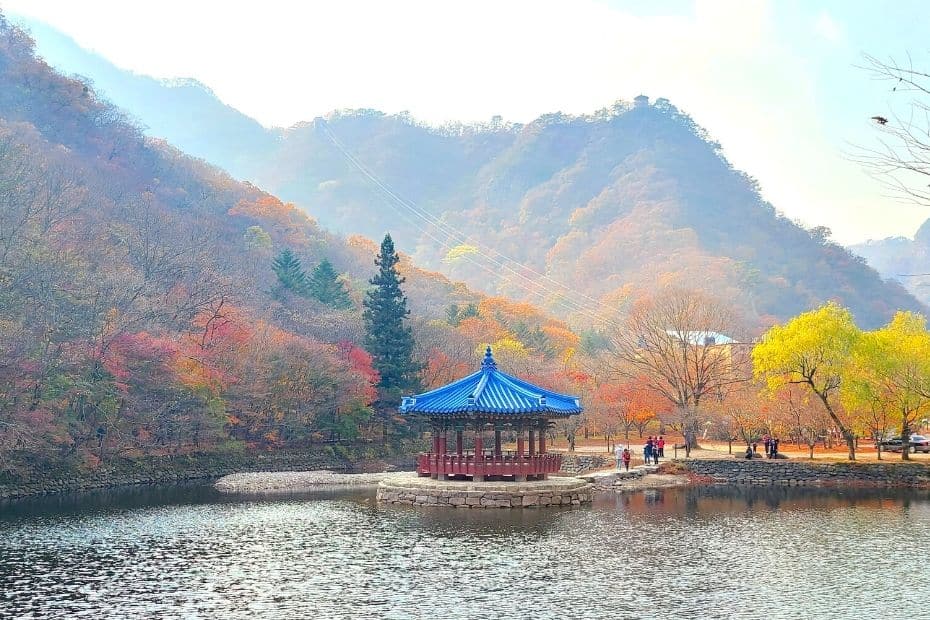
Providing picture-postcard style views, the Uhwajeong Pavilion is a traditional Korean-style rest station with a bright blue roof. It is uniquely placed in the centre of a lake, surrounded by willowy trees that gently brush the lake’s edge.
The imperious mountains covered with fall foliage finish the scene and create an impressive backdrop. The pavilion is best viewed from the edge of the lake, or on the stone walkway that leads up to it. This spot provides truly iconic scenes that show Korea’s true beauty.
Yeonjabong Peak Observatory And Naejangsan Cable Car

For those who want to see the wooded valleys and rocky slopes without breaking a sweat on the way to the top, there’s the Naejangsan Cable Car, which will whisk you all the way up to the Yeonjabong Peak Observatory. From here you can enjoy some of the best views of the park, where the fall foliage paints a mosaic on the valley below.
Hiking At Naejangsan National Park
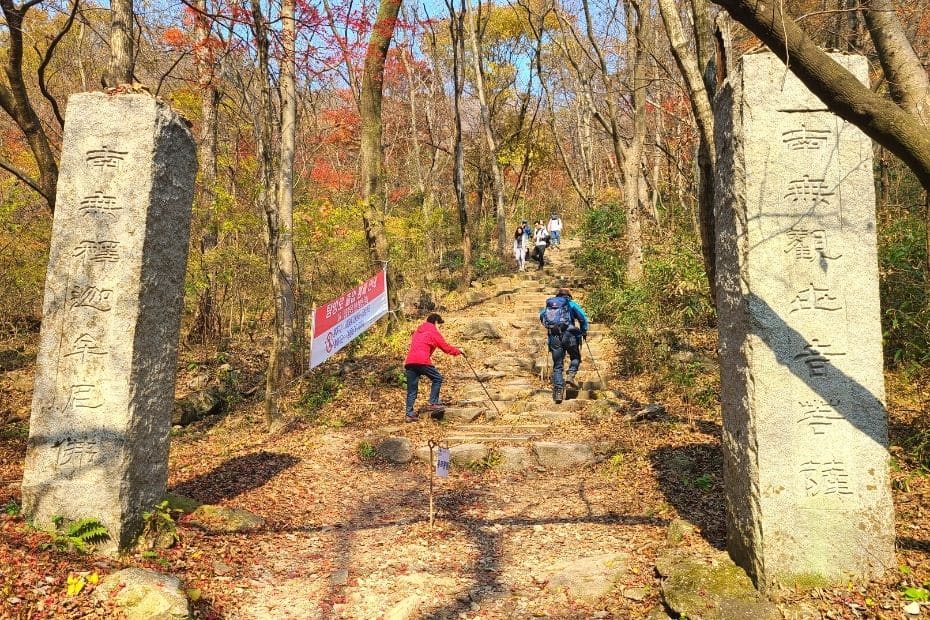
For many visitors, seeing the sights of Naejangsan National Park is best enjoyed with a backpack and from the top of the small but challenging peaks that overlook the central valley.
The highest peak is Sinseonbong Peak, standing tall at 763m high. Most of the hiking courses are ‘intermediate’, which means they’re suitable for people in reasonable condition.
You’ll find plenty of Korean families hiking along the many well-maintained hiking routes in the park. The cable car will give people a good head-start should they not want to tackle the ascent at the start.
For some of my top hiking in Korea tips, check out these great Hiking In Korea Tips.
Below is a map of the main hiking trails in Naejangsan National Park.
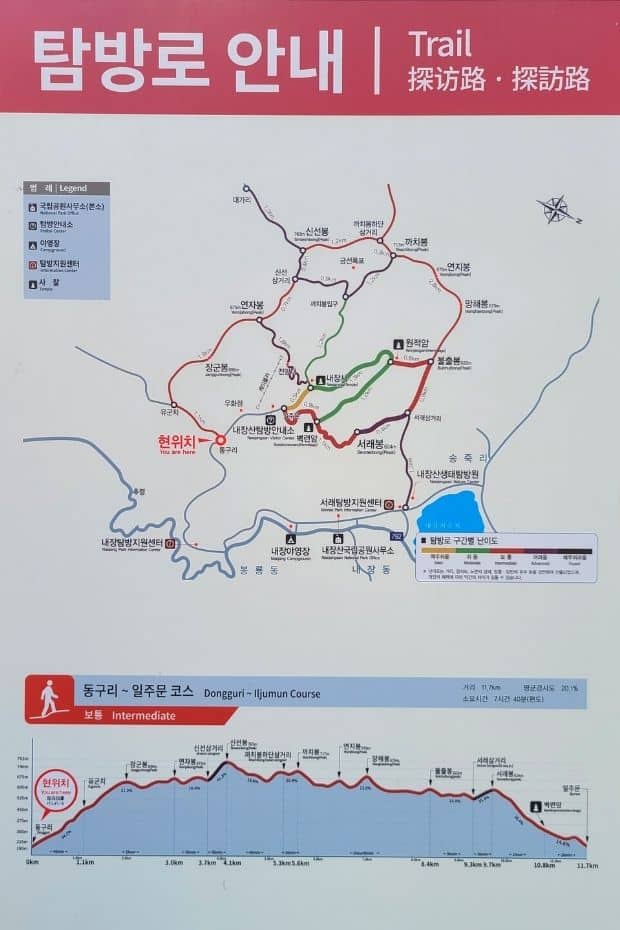
Eating At Naejangsan National Park
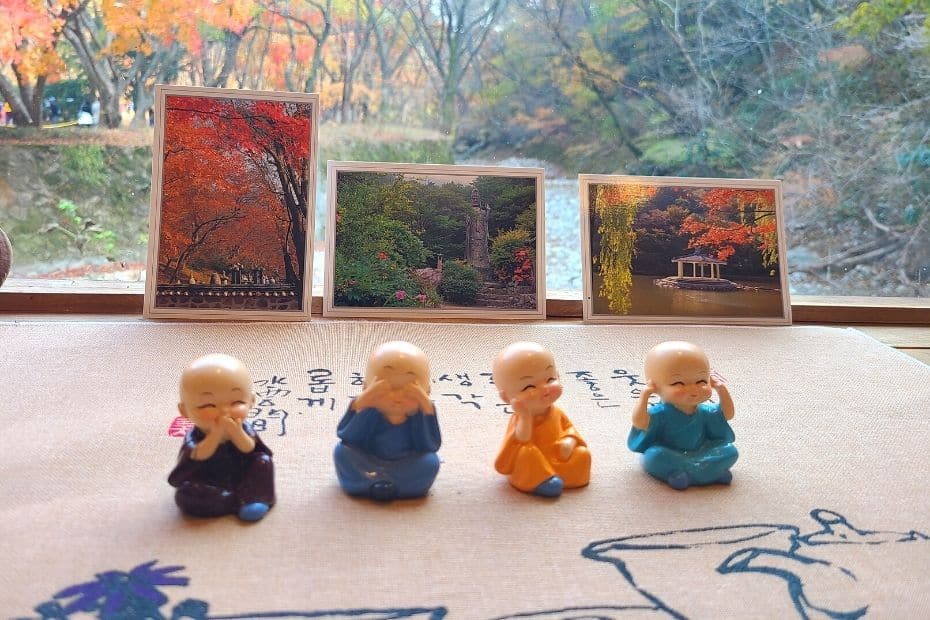
Visiting a national park in Korea provides the opportunity to experience some of the best Korean traditional dishes, and Naejangsan has a great selection of delicious dishes to savor.
During autumn, there are dozens of extra food stalls offering up seasonal specialties, such as roasted chestnuts, as well as the usual street food snacks like hotteok 호떡 (sweet pancake), odeng 오뎅 (fish-cake in soup), and tteokbokki 떡볶이 (spicy fried rice cake).
Traditional restaurants line the entrance of the park where you can indulge in bibimbap 비빔밥 (mixed rice with veg), haemul pajeon 해물파전 (seafood pancake), and lots of other great dishes. There are other restaurants that sell popular Korean dishes, such as donkasu (pork cutlet), as well.
If you want a break in a cute cafe, check out the one near Naejangsa Temple (pictured above). You can sip a warming coffee whilst watching the leaves drop on the ground outside.
There are also lots of nice souvenirs for sale here, including these little Buddha dolls and postcards. Be sure to pick one up as a souvenir of your journey.
Slow Post From Naejangsan

If you travelled to Naejangsan through Jeongeup Station, there’s another fun souvenir that you can send from the station to yourself (or someone else living in Korea).
Called Neurin 느린 (slow) Post, you can mail a postcard with views from Naejangsan on it. However, the postcard is delivered a year later – hence the name ‘slow post’.
You can write a message for the future, to remind yourself of the fun and experiences you had during a day out at Naejangsan National Park.
FAQ About How To Go To Naejangsan National Park
Finally, here’s a few FAQs about how to go to Naejangsan National Park, in case the above information didn’t cover enough for you.
What’s the fastest way to get to Naejangsan National Park from Seoul
The fastest way to go to Naejangsan National Park from Seoul is by driving. Alternatively, take the KTX train from Seoul Station to Jeongeup Station and then take bus 171 to the park entrance. These should both take just over 3 hours.
When is the best time to visit Naejangsan National Park?
The best time to visit Naejangsan National Park is the first week of November. This is when the fall foliage is on full display and the most incredible scenes can be seen.
What can you see at Naejangsan National Park?
There are many sights to see at Naejangsan National Park, including the Maple Tree Path, Uhwajeong Pavilion, Naejangsa Temple, Naejangsan Cable Car and the Yeonjabong Peak Observatory. There are many pine and maple trees, as well as golden gingko trees.
How can you go to Naejangsan National Park from Jeongeup City
To get to Naejangsan National Park from Jeongeup City, take bus number 171 from outside Jeongeup Station. Alternatively, take a taxi from anywhere in the city to the Naejangsan Rest Stop (내장터미널휴게소).
Is there parking at Naejangsan National Park?
Yes, there are parking spaces at the Naejangsan Rest Stop (내장터미널휴게소), as well as in other car parks before the park’s entrance. You will need to park at the Naejangsan Rest Stop before entering the main park as cars are not allowed inside.
Are there autumn leaves at Naejangsan National Park?
Yes, Naejangsan National Park is one of the top places to see autumn leaves in Korea. The peak time for autumn leaves at Naejangsan National Park is early November.
Liked This? Pin It For Others
If you enjoyed reading this article, then please share this with your friends on Pinterest.
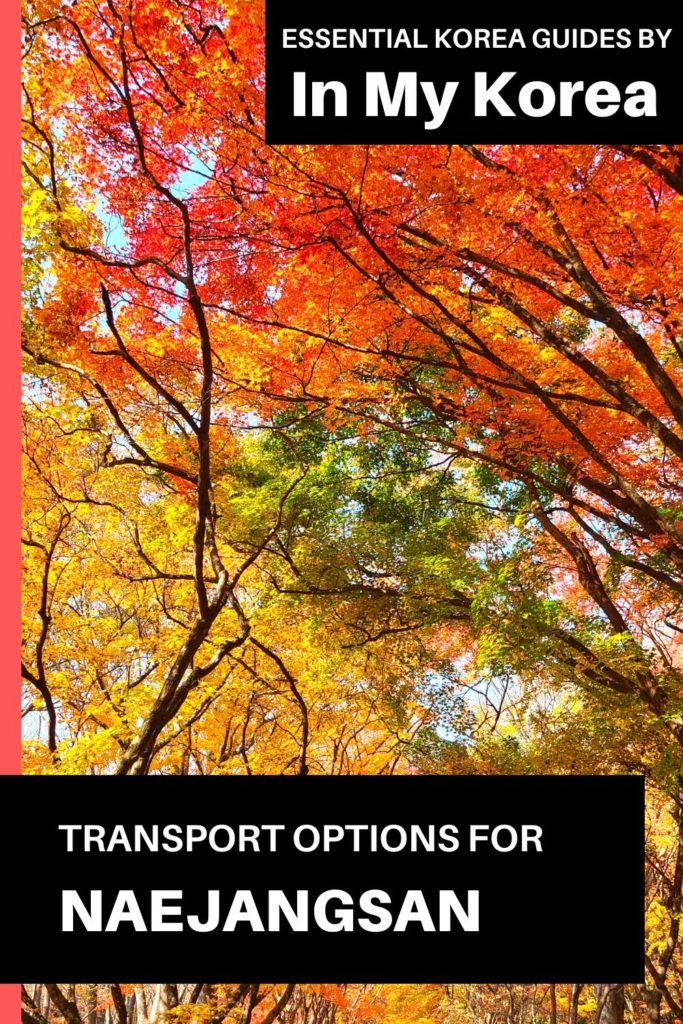
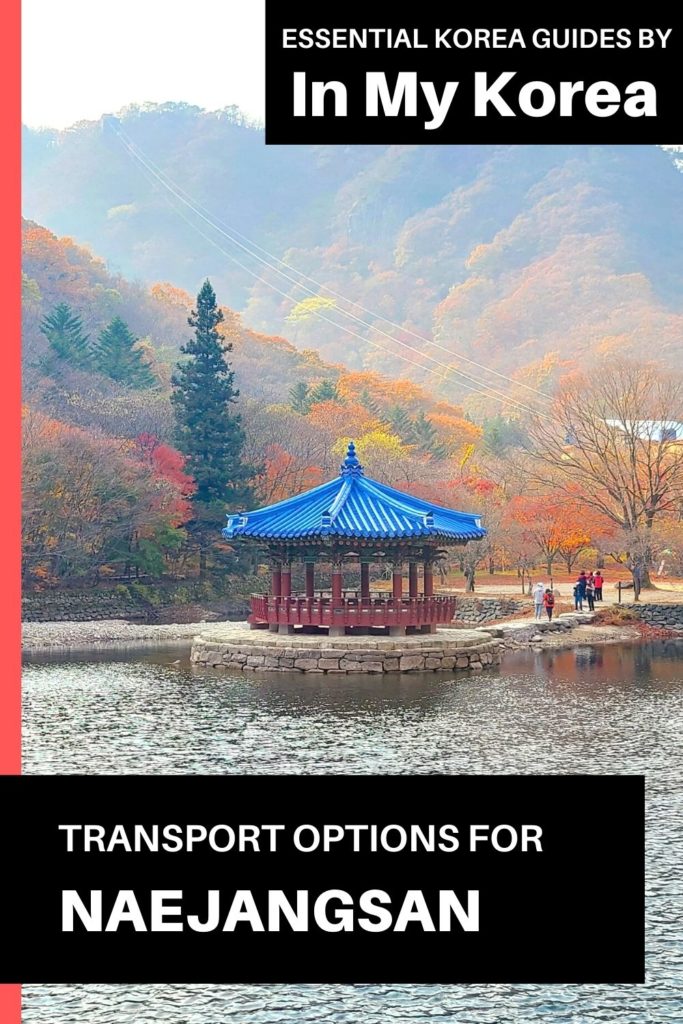




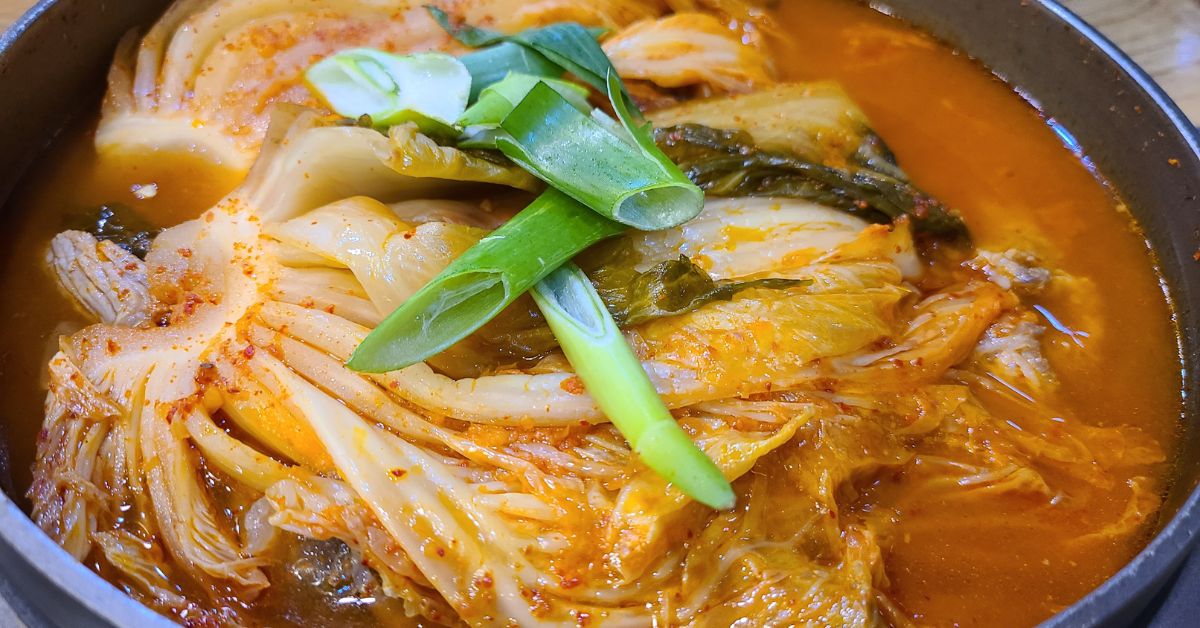
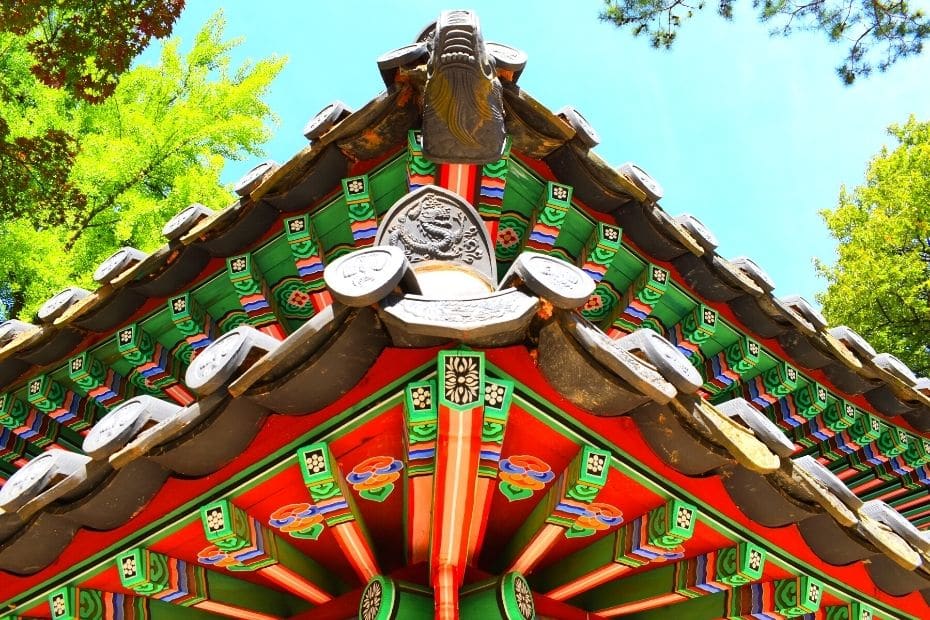

Hi, may I know how far the car park from Naejangsan rest stop to the entrance is since cars are not allowed inside? Could you please tell me approximately how many minutes walk? Thks.
Hi, to walk from the Naejangsan rest stop (내장터미널휴게소) to the park entrance doesn’t take more than 10 minutes. However, to get to the central area where the cable car, restaurants, pavilion etc., are takes about 30 minutes from the rest stop. There’s a shuttle bus that takes you from the rest stop to the main entrance so you don’t have to walk.
Hi,
Would you recommend staying overnight in the nearby town? 3 hours x 2 way of driving seems quite a lot for a day.
Hi, there’s not a lot to do in the town, but if you want to maximise your time in the park, then it could be worth it, yeah. However, you can see a lot of the park in one day so a second day might not be so worthwhile.